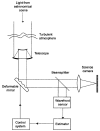Objective assessment of image quality. IV. Application to adaptive optics
- PMID: 17106464
- PMCID: PMC2596685
- DOI: 10.1364/josaa.23.003080
Objective assessment of image quality. IV. Application to adaptive optics
Abstract
The methodology of objective assessment, which defines image quality in terms of the performance of specific observers on specific tasks of interest, is extended to temporal sequences of images with random point spread functions and applied to adaptive imaging in astronomy. The tasks considered include both detection and estimation, and the observers are the optimal linear discriminant (Hotelling observer) and the optimal linear estimator (Wiener). A general theory of first- and second-order spatiotemporal statistics in adaptive optics is developed. It is shown that the covariance matrix can be rigorously decomposed into three terms representing the effect of measurement noise, random point spread function, and random nature of the astronomical scene. Figures of merit are developed, and computational methods are discussed.
Figures
References
-
- Barrett HH, Myers KJ. Foundations of Image Science. Wiley; 2004.
-
- Barrett HH. Objective assessment of image quality: effects of quantum noise and object variability. J. Opt. Soc. Am. A. 1990;7:1266–1278. - PubMed
-
- Barrett HH, Denny JL, Wagner RF, Myers KJ. Objective assessment of image quality: II. Fisher information, Fourier crosstalk, and figures of merit for task performance. J. Opt. Soc. Am. A. 1995;12:834–852. - PubMed
-
- Barrett HH, Abbey CK, Clarkson E. Objective assessment of image quality: III. ROC metrics, ideal observers and likelihood-generating functions. J. Opt. Soc. Am. A. 1998;15:1520–1535. - PubMed
-
- Zhang H.Signal detection in medical imaging Ph.D. dissertation 2001University of Arizona; Tucson, Ariz.
Publication types
MeSH terms
Grants and funding
LinkOut - more resources
Full Text Sources


